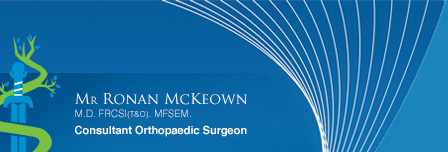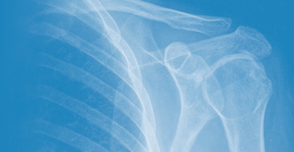|
Therapist Information and
Guidelines
Rotator Cuff Repair
Accelerated Rehabilitation Program
Print
Friendly PDF Page (Click Here)
Most repairs are now performed
arthroscopically so there is less tissue trauma
and reduced risk of adhesions. Post-op stiffness
of the shoulder is rarely a problem, so the
priority is to protect the repair from breaking
down.
All rotator cuff repairs will be
placed in an Abduction Brace.
The Accelerated Rehab Program is
used in patients with good quality tendon and a
robust repair. This is determined by the Mr
McKeown intra-operatively.
The abduction cushion should sit
laterally on the trunk and should be worn at all
times by the patient (night and day).
Clothing should be applied over the brace for
the 1st 3 weeks, some straps may be opened for
hygiene requirements and certain exercises but
the arm should not be removed from the sling.
After 3 weeks the patient can
dress the affected arm. To do this the arm
should be taken passively out from the sling by
a carer and sleeve applied – the arm should be
maintained in abducted position and returned to
the sling afterwards.
Always be guided by the
patient's pain. Do not force, stretch or stress
the repair before 8 weeks.
Strengthening should not begin
before 4 weeks.
Patients should not drive for
6-8 weeks.
Consideration should always be
given to the individual patients’ ability. The
guidelines are based on maintaining range of
movement in the 1st phase and then gradually
building strength in the middle to last phase.
Progression should be tailored to the individual
patient but the times quoted should be the
earliest for active movement and when
strengthening (resisted exercises) begins.
Post Op
Day 1 – 2 Weeks:
Patients arm within the
brace
Finger, wrist & RU joint exercises.
Elbow flexion / extension (within sling).
Shoulder girdle exercises.
Commence scapula setting.
2 Weeks:
Commence pendular exercises
along plane of the abduction cushion i.e.
abduction cushion to remain in situ throughout
exercises.
Commence passive shoulder flexion (in neutral
rotation) to 90°
These should be carried out with brace in situ
and patients arm returned to the abducted
position – not to neutral.
4 Weeks:
Wean out of brace.
Commence active assisted exercises in all
directions.
Progress to active exercises and increase range
as pain allows.
Commence gentle isometric rotator cuff
strengthening exercises in neutral initially.
Commence anterior deltoid strengthening as ROM
allows.
Progress to isotonic strengthening as able,
gradually increasing resistance and range.
Commence proprioreceptive exercises.
Scapular setting and core stability.
Encourage functional movements at waist level.
Return to
Functional Activities
These are approximate and will
differ depending upon the individual. However,
they should be seen as the earliest that these
activities should commence.
Driving: 6-8 Weeks
(Patient must feel safe to drive).
Swimming: Breaststroke: Approx 8
Weeks.
Freestyle: 3 Months.
Golf: 3 Months.
Lifting: No heavy lifting for 3
months. After this be
guided by the strength of the patient.
Return to work: Dependant upon
the patient's occupation.
Sedentary job: 6 Weeks.
Manual workers: Should be guided
by Mr McKeown
at least 3 months.
|







